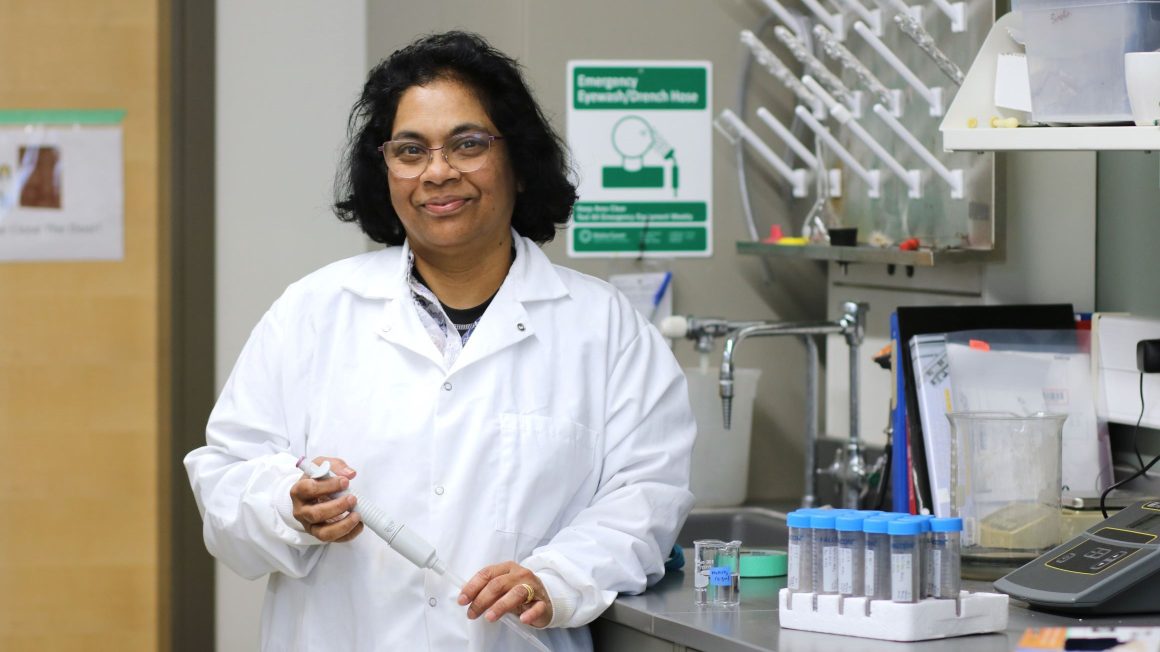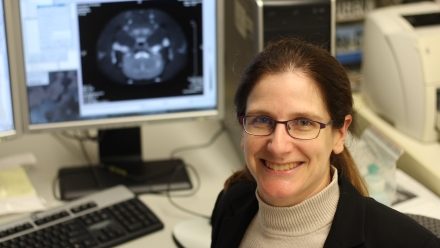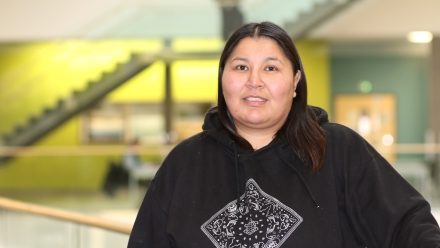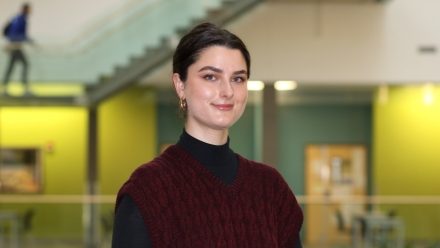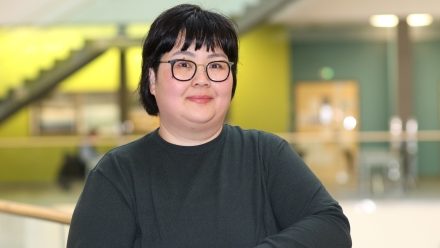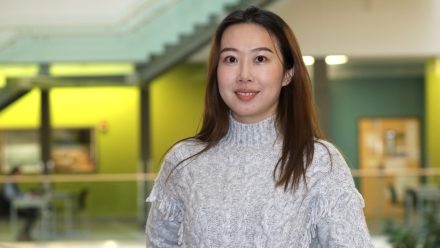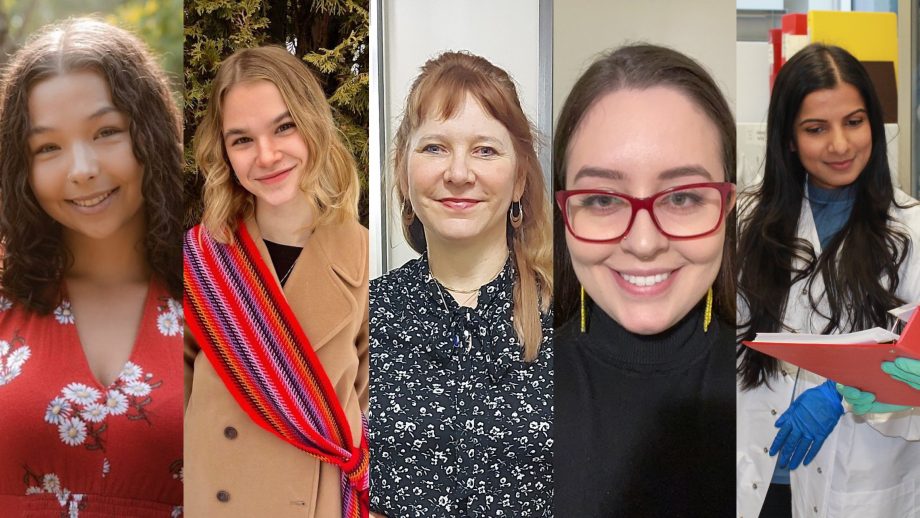February 11 is the International Day of Women and Girls in Science. To recognize this day, The University of Winnipeg is highlighting some of the accomplished women working in the sciences on campus, while also shedding light on the challenges women often face working in these spaces.
The University of Winnipeg is honoured to have these women, and many more, making outstanding contributions to scientific research through their work and studies at UWinnipeg and in the community.
Dr. Srimathie Indraratne
Associate professor in Environmental Studies and Sciences, Dr. Srimathie Indraratne, is a soil scientist whose research focuses on methods to keep soil contaminants out of our food systems and water bodies.
“Human health, water quality, everything is dependent on the quality of the soil,” she said. “Contaminants will be taken up by the plant through the fruits you eat and any vegetables or grains you eat. It is coming through the food chain into humans and wildlife. So, we have to cut off this transferring from soil to food.”
Prior to migrating to Winnipeg in 2015, Dr. Indraratne was a university professor in Sri Lanka and said she routinely travelled across the country to characterize soil. She says this kind of field activity may be one of the reasons soil science is highly underrepresented by women.
“Especially when you are young,” she said. “You’re bringing up your kids, your career is at its peak, and you can’t give up either. You really need support.”
Dr. Indraratne said it’s important to recognize the added family responsibilities many women in science have, and to work to accommodate and provide alternatives – something she said is already happening at UWinnipeg.
“If there are periods when field work becomes too challenging, students can choose to conduct carefully-constructed laboratory research,” she said. “They can have simulated studies in the laboratories. Many of my students are doing that. They can go for greenhouses, still under controlled conditions, or they can go into the field. They have options.”
Jessica de Kort
Third year physics student, Jessica de Kort, moved to Winnipeg from British Colombia to study Medical Physics at The University of Winnipeg and pursue recreational dance with the Royal Winnipeg Ballet.
Through her research, she is working to make improvements to a prostate cancer treatment called brachytherapy. de Kort’s research has been featured at the Canadian Undergraduate Medical Physics Conference, the Medical Physics Summer Student Symposium in Manitoba, and, in January of this year, at the Canadian Conference for Undergraduate Women in Physics in Montreal.
She said it has been exciting to meet more women in the field of physics at events like these, since she is the only woman in third year physics at UWinnipeg.
“There are days where I wish I had a girl group around,” de Kort said. “There are not a lot of people in physics, and definitely not a lot of women in physics.”
She hopes to eventually work with medical imaging machines, and hopes her work will help build a more inclusive image for physicists.
“In kindergarten you hear the word scientist and the first thing that pops in our head is someone that looks like Albert Einstein,” de Kort said. “But when you hear ‘women in physics’ what do you think of? We don’t really know. If we can change that then there might be more women in physics.”
Dr. Melanie Martin
Dr. Melanie Martin, is a professor of Physics at UWinnipeg and co-director of the University of Winnipeg Brain Imaging and Metabolic Research Lab.
Dr. Martin is a long-time advocate for equity, diversity, and inclusion (EDI).
“Studies have shown over and over again that having a diverse group of people working on problems leads to better outcomes,” she said. “EDI is also leading to friendlier and more supportive work environments.”
Dr. Martin believes having more women in science will lead to increased research on women’s issues that have “traditionally been ignored by men in the field.”
“Health problems for women are understudied and underfunded, leaving many women suffering,” she said.
Dr. Martin is currently studying multiple sclerosis, which she said affects nearly four times as many women as men, and Alzheimer’s disease, which more commonly affects women than men. She also supervises several women in her lab who she said are talented, resourceful, and hardworking scientists.
“It is really rewarding to see them succeed,” Dr. Martin said. “As I watch them develop their science skills and become more independent researchers, I know our future will be great, being led by talented scientists like those in my lab.”
Meet the scientists of the University of Winnipeg Brain Imaging and Metabolic Research Lab
Melissa Anderson
Melissa Anderson is a Biomedical Engineering PhD student working to help make magnetic resonance imaging (MRI) and positron emission tomography (PET) images clearer and better-suited for diagnosis and quantitative analysis.
Anderson is an advocate and a leader in the UWinnipeg community, who supports other women in science while balancing her family responsibilities.
“Women deserve recognition for pursuing the sciences, while being aware they are going into a male-dominated field,” she said. “I am proud that I am a mother of four who is excelling in the science field in a space that was not meant for me.”
Anderson would like to see more representation for women in science.
“You belong in this space as much as anyone else,” she said.
Anderson is the first in her family to receive a master’s degree and the first to be working towards a PhD.
“I love science because it allows you to find out reasons why something is how it is,” she said. “As well as helping people, whether it is trying to find a cure for a disease or teaching/mentoring others.”
Madison Chisholm
Madison Chisholm has been a student at UWinnipeg since 2012. She began as a high-school student at the Collegiate and is now working on a Master of Science degree in Bioscience, Technology and Public Policy.
“I’ve been fortunate to work on projects in the University of Winnipeg Brain Imaging and Metabolic Research Lab for the past few years,” she said. “I was drawn to pursue a career in science because I love problem-solving.”
Chisholm calls herself a first-generation university student. She was the first person in her family to attend and graduate from post-secondary education, something she said she is very proud of.
She believes women in science should be celebrated for the unique perspectives they bring to their research.
“I think increasing diversity in science expands the pool of talented researchers,” she said, “bringing in new perspectives, talents, and creativity when approaching scientific problems.”
Emma Friesen
Undergraduate student, Emma Friesen, is set to graduate in June 2024 with a B.Sc. Honours in Biochemistry with a minor in Mathematics.
She was a member of the Wesmen Women’s Soccer Team from 2019-2023 with Academic All-Canadian Status and received two Undergraduate Student Research Awards from the Natural Sciences and Engineering Research Council of Canada.
“Scientific research in medicine excites me,” Friesen said. “My goal is to attend medical school and simultaneously work on a PhD in a medical field to combine my love for medicine and research.”
Friesen said it isn’t always easy being a woman in STEM.
“Certain individuals in science assume you don’t belong or you aren’t smart enough to be there,” she said. “But you just need to take their disapproval as something to prove wrong, and to show them you deserve to be exactly where you are.”
After graduation, Friesen will be attending graduate school at the University of British Columbia to pursue a Master of Science degree in Interdisciplinary Oncology.
Dr. Sheryl Herrera
Dr. Sheryl Herrera is a Senior Research Associate for the Brain Imaging and Metabolic Research Lab. She completed undergraduate studies at UWinnipeg, and returned here to complete her Postdoctoral Fellowship (2018-2020) after graduate school at the University of Manitoba.
“My research was on developing and applying quantitative imaging modalities (MRI, PET) to understand changes in anatomy and function due to disease and disorders,” she said.
As a first-generation, Canadian-born Filipino, Dr. Herrera said she faced family pressure to follow a career path her parents were more familiar with.
“To become the scientist that I am now isn’t something they quite understand,” she said. “I think being a student at UW, and meeting my peers and the professors at the Physics department, helped me decide that this was what I wanted to do.”
Dr. Herrera said she is glad to see women in the science field slowly becoming more common.
“I wish when I was growing up there would have been more people who looked like me who were doing interesting things in science,” she said. “I hope that I could eventually be that for someone else – being a mentor to someone who, like myself, is a person of colour and a woman.”
Yujie Ren
Biosciences graduate student, Yujie Ren, is engaged in research and development in the field of intraoperative magnetic resonance imaging (iMRI). She is working to help address complications encountered during neurosurgical procedures.
Ren said she is fascinated with the complexities of the human brain and the quest to unravel the mysteries behind neurodegenerative diseases, such as Alzheimer’s.
“What I find particularly interesting is the interdisciplinary nature of neuroscience research,” she said. “It involves the integration of various scientific disciplines, such as genetics, biochemistry, and neuroimaging, to comprehensively approach the complexities of neurodegenerative diseases.”
Ren said she is grateful for the chance to learn and grow under the guidance of Dr. Martin and her team members. She also appreciates collaboration between researchers from all backgrounds, and the resilience of women in the sciences.
“In our collective pursuit of understanding the unknown, gender should never be a barrier,” she said, “but rather a celebration of the diverse perspectives that contribute to the richness of scientific exploration.”

